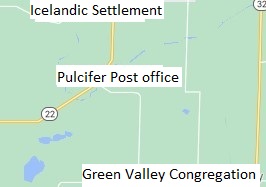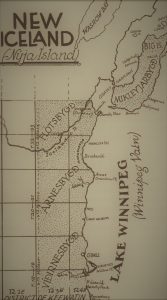 Páll Þorláksson graduated from Concordia Seminary in St. Louis in June 1875 and was ordained as a priest in the Norwegian Synod on July 8, 1875. At this time, westward migration from Iceland was increasing, and Sigtryggur Jónasson took nearly 1,200 Icelanders to Winnipeg in late summer, and the journey was called to New Iceland at Lake Winnipeg. Icelanders who had come west and had settled in Wisconsin naturally followed this migration, but there was no interest among them to move out into the wilds of Manitoba. They had settled in Ljósavatnssýsla (Shawano County) in Wisconsin and had formed an Icelandic settlement there. Reverend Páll had relationships with quite a few of the settlers there, e.g., his parents and other relatives and friends were there. Undoubtedly Reverend Páll had made the board of the Norwegian Church Synod aware of this, because in August he is appointed parish priest of four Norwegian congregations in the said northern part of Wisconsin near Shawano. They were the Strand Congregation in Maple Valley, Oconto County, Leeman Congregation in Navarino, Shawano Congregation in Jerusalem and finally Green Valley Congregation, with the last three congregations were all in Shawano. The largest of these Norwegian congregations was in Green Valley. After the inauguration in St. Louis Séra Páll’s went to his parents, and it is there where he is ordained a priest in the Norwegian congregations. In mid-October, he had formed a congregation in the Icelandic settlement, The Icelandic Lutheran Congregation in Shawano County.
Páll Þorláksson graduated from Concordia Seminary in St. Louis in June 1875 and was ordained as a priest in the Norwegian Synod on July 8, 1875. At this time, westward migration from Iceland was increasing, and Sigtryggur Jónasson took nearly 1,200 Icelanders to Winnipeg in late summer, and the journey was called to New Iceland at Lake Winnipeg. Icelanders who had come west and had settled in Wisconsin naturally followed this migration, but there was no interest among them to move out into the wilds of Manitoba. They had settled in Ljósavatnssýsla (Shawano County) in Wisconsin and had formed an Icelandic settlement there. Reverend Páll had relationships with quite a few of the settlers there, e.g., his parents and other relatives and friends were there. Undoubtedly Reverend Páll had made the board of the Norwegian Church Synod aware of this, because in August he is appointed parish priest of four Norwegian congregations in the said northern part of Wisconsin near Shawano. They were the Strand Congregation in Maple Valley, Oconto County, Leeman Congregation in Navarino, Shawano Congregation in Jerusalem and finally Green Valley Congregation, with the last three congregations were all in Shawano. The largest of these Norwegian congregations was in Green Valley. After the inauguration in St. Louis Séra Páll’s went to his parents, and it is there where he is ordained a priest in the Norwegian congregations. In mid-October, he had formed a congregation in the Icelandic settlement, The Icelandic Lutheran Congregation in Shawano County.
Reverend Thorlaksson´s Congregations in New Iceland
 Saga Íslendinga í Vesturheimi III says in one place: “Early in the year 1877, shortly after the Parliament was formed in New Iceland, it was discussed at one of the meetings that it was necessary for a priest to be in the colony, and to soon build as many churches or schoolhouses as would be needed. In the spring of April 27th and 28th, the residents of Fljóts settlement (Icelandic River) held a meeting about this matter. The majority of people were in favor of getting a priest, providing money for his salary and building churches as needed. This “larger part” were the people who were against Reverend Páll Þorláksson becoming a priest in the colony and wanted it to be known that even if he had several times renewed his offer to become a priest there, it would not be accepted. The result was that the Icelanders in the colony formed a church synod of their own, which was not dependent on other church synods in the West. A committee of people was elected to provide (two) priests, to negotiate with other villages in the colony about pastoral services, to see that churches would be established, and to decline Reverend Páll’s pastoral services. At the same time, the same kind of meetings were held in the other settlements. But there, people’s opinions about the priestly matters became more divided. In Mikley and the greater part of the Víðirnes settlement, people followed most of the policies of Fljóts settlement, but the settlers in Árnes settlement and the smaller part of Víðirnes settlement, did not think there were enough reasons to refuse Reverend Páll’s invitation. Then the Lutheran group of Icelanders split for the first time in the West. But when things got to such a point that Árnes settlement was out of the game, some parts of Víðirnes settlement and many followers of Reverend Páll both at the Fljóts and out in Mikley, then no promise was received from the other three villages for more money than was enough to pay one priest.” Reverend Páll moved to New Iceland in the fall of 1877 without having received a formal letter of call, but it is worth mentioning that 120 heads of household in New Iceland signed a letter of defiance to Reverend Páll asking him to undertake pastoral service in the colony. Soon after arriving there, the priest worked on the formation of congregations in the settlement and together with others he drafted proposals for congregational laws. They named the association Hinn Íslenzki Lúterski söfnuður (The Icelandic Lutheran Synod in New Iceland) í Nýja Íslandi, and to the association belonged Vídalín Congregation in Víðirnes settlement, Hallgríms Congregation in the southern part of Árnes settlement and Guðbrands Congregation in the northern part of the same settlement. Rev. Páll also had followers in the Fljóts settlement and in Mikley.
Saga Íslendinga í Vesturheimi III says in one place: “Early in the year 1877, shortly after the Parliament was formed in New Iceland, it was discussed at one of the meetings that it was necessary for a priest to be in the colony, and to soon build as many churches or schoolhouses as would be needed. In the spring of April 27th and 28th, the residents of Fljóts settlement (Icelandic River) held a meeting about this matter. The majority of people were in favor of getting a priest, providing money for his salary and building churches as needed. This “larger part” were the people who were against Reverend Páll Þorláksson becoming a priest in the colony and wanted it to be known that even if he had several times renewed his offer to become a priest there, it would not be accepted. The result was that the Icelanders in the colony formed a church synod of their own, which was not dependent on other church synods in the West. A committee of people was elected to provide (two) priests, to negotiate with other villages in the colony about pastoral services, to see that churches would be established, and to decline Reverend Páll’s pastoral services. At the same time, the same kind of meetings were held in the other settlements. But there, people’s opinions about the priestly matters became more divided. In Mikley and the greater part of the Víðirnes settlement, people followed most of the policies of Fljóts settlement, but the settlers in Árnes settlement and the smaller part of Víðirnes settlement, did not think there were enough reasons to refuse Reverend Páll’s invitation. Then the Lutheran group of Icelanders split for the first time in the West. But when things got to such a point that Árnes settlement was out of the game, some parts of Víðirnes settlement and many followers of Reverend Páll both at the Fljóts and out in Mikley, then no promise was received from the other three villages for more money than was enough to pay one priest.” Reverend Páll moved to New Iceland in the fall of 1877 without having received a formal letter of call, but it is worth mentioning that 120 heads of household in New Iceland signed a letter of defiance to Reverend Páll asking him to undertake pastoral service in the colony. Soon after arriving there, the priest worked on the formation of congregations in the settlement and together with others he drafted proposals for congregational laws. They named the association Hinn Íslenzki Lúterski söfnuður (The Icelandic Lutheran Synod in New Iceland) í Nýja Íslandi, and to the association belonged Vídalín Congregation in Víðirnes settlement, Hallgríms Congregation in the southern part of Árnes settlement and Guðbrands Congregation in the northern part of the same settlement. Rev. Páll also had followers in the Fljóts settlement and in Mikley.
North Dakota
Above, it was stated that a split occurred with the inhabitants of New Iceland due to religious issues. Reverend Páll was paid by a Norwegian church association, while the supporters of Reverend Jón Bjarnason paid his salary. This and many other things caused the “Pálsmen” to turn to their leader, Reverend Páll, and ask for his help in emigrating from New Iceland and trying to settle elsewhere. The priest did not shy away, but organized a land search south of the border, even as far south as Minnesota. He called two men from his ranks to join him, and they went by steamboat up the Red River to Pembina, N. Dakota. They had been advised to explore the area west of Pembina and they did so. Finding a favorable area east of the so-called Pembina Mountains or Hills, an Icelandic settlement began there in 1877. In the following years, Reverend Páll’s congregation members moved south to the new settlement area in N. Dakota, and despite Reverend Páll’s growing illness, he began to form congregations and schools in 1880. At the beginning of the year, three children’s and youth schools had were formed and in the autumn it came to church matters. Rev. Páll called a meeting in the Park River district which was held on November 24, 1880 and 12 people attended it, including Stephan G. Stephansson. He had the idea of a name for the congregation, which was called Gardar Congregation. Six days later, a similar meeting was held in Vík (now Mountain) and it was initially called Víkur Congregation, but today it is called Mountain Congregation. The last meeting was held at Jóhann Hallsson’s home on January 2, 1881, and there the Tongue River Congregation was founded in the Hallson settlement.
